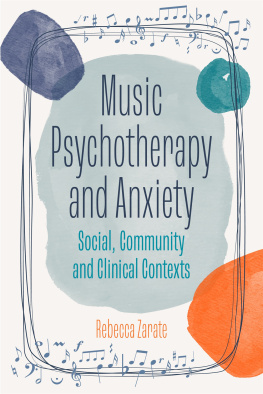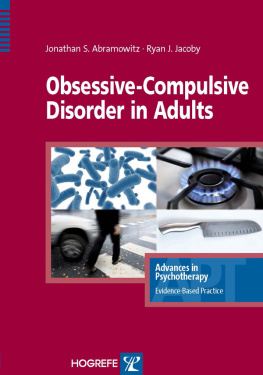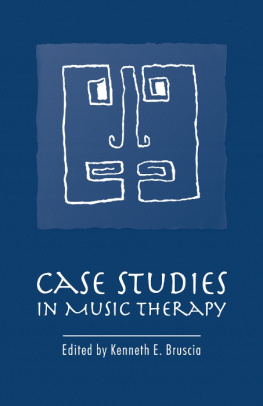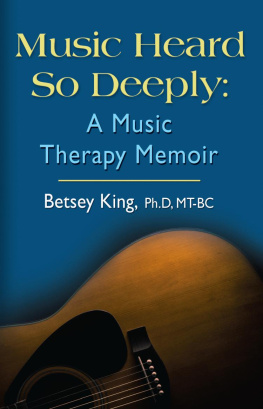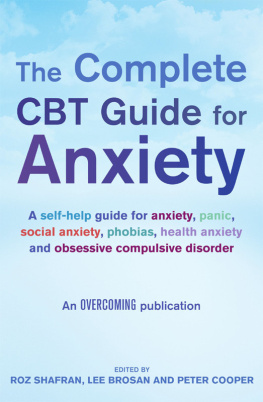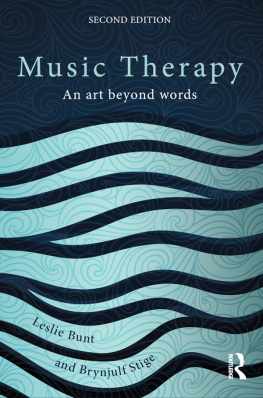Contents
Page list

of related interest
Creative DBT Activities Using Music
Interventions for Enhancing Engagement and Effectiveness in Therapy
Deborah Spiegel with Suzanne Makary and Lauren Bonavitacola
ISBN 978 1 78775 180 4
eISBN 978 78775 182 8
Music Therapy in a Multicultural Context
A Handbook for Music Therapy Students and Professionals
Edited by Melita Belgrave and Seung-A Kim
ISBN 978 1 78592 798 0
eISBN 978 1 78450 807 4
Music Therapy in Adoption and Trauma
Therapy That Makes a Difference After Placement
Joy Gravestock
Foreword by Helen Odell-Miller
ISBN 978 1 78592 523 8
eISBN 978 1 78450 912 5
Music
Psychotherapy
and Anxiety
SOCIAL, COMMUNITY,
AND CLINICAL CONTEXTS
Rebecca Zarate

First published in Great Britain in 2022 by Jessica Kingsley Publishers
An imprint of Hodder & Stoughton Ltd
An Hachette Company
Copyright Rebecca Zarate 2022
The right of Rebecca Zarate to be identified as the Author of the Work has been asserted by her in accordance with the Copyright, Designs and Patents Act 1988.
All rights reserved. No part of this publication may be reproduced, stored in a retrieval system, or transmitted, in any form or by any means without the prior written permission of the publisher, nor be otherwise circulated in any form of binding or cover other than that in which it is published and without a similar condition being imposed on the subsequent purchaser.
A CIP catalogue record for this title is available from the British Library and the Library of Congress
ISBN 978 1 78775 597 0
eISBN 978 1 78775 598 7
Jessica Kingsley Publishers policy is to use papers that are natural, renewable and recyclable products and made from wood grown in sustainable forests. The logging and manufacturing processes are expected to conform to the environmental regulations of the country of origin.
Jessica Kingsley Publishers
Carmelite House
50 Victoria Embankment
London EC4Y 0DZ
www.jkp.com
For Luis,
My love, light and inspiration. Your unwavering support keeps me creative and courageous.
For my family,
You have shared me with my passion for music therapy in ways that are immeasurable.
Without you all believing in me and the beautiful work of music therapy, this book would not exist.
Acknowledgements
First and foremost, I want to acknowledge my clients because without their bravery to be in the work and the vulnerability and trust that entails, none of this work would exist. I remain humble and honored to have been witness to their process and transformation. I have been lucky enough to have incredible mentors in my life. This book would also not be possible without them, and whose music wisdom I bring with me every day to the work. I cannot name everyone, but you all know who you are. You have nourished me and provided me with the conditions to be the person I am today. My family mentors, my friend mentors, my professional mentors, I carry a deep gratitude for you all.
Thank you to my music therapy and creative arts therapy community both national and international friends and colleagues. Particularly to my dear friends in our Flow-er Power Change Process Research group!
Deepest gratitude to Barbara Hesser for your constant support and guidance.
My sincere gratitude to my Lesley community and the incredible amount of support I have received for doing this book, from the idea through to the finished product. Particularly to my fabulous colleagues in the Expressive Therapies Department. I am truly humbled and warmed by your professional and personal generosity of time and care for me and this piece of work.
It takes a village, and I could not have done this project without the support of our home community, especially while my husband and I were extremely ill with covid in early 2020 through to 2021. Thanks to Bob, Terry, Nancy, Patrick, Nick, Emily, Julia, McKenna, David, Jimmy and Nancy for being the best, caring neighbors, friends, and supporters.
Last, but certainly not least, a loving shout out to my goldendoodle pups and writing buddies, Shea Shea and Logi, who constantly reminded me that naps do help! They brightened up my day when I couldnt write a single word by just being cute and fluffy.
Contents
Preface
Introduction to the dimensions of anxiety model
Concerns about anxiety and the devastating impact it can have on peoples lives and community infrastructures have been increasing over the past several years. Particular attention has been placed on the relationship of anxiety to the increase of burnout and fatigue in healthcare professionals, cyberbullying behaviors, social hostility, and random or surprise acts of violence in various settings, including community gatherings and education campuses. More recently, the concerns for other manifestations of anxious and stressed behaviors in people have increased as the world has been experiencing a global pandemic. It has taken a hold on individual, collective, and systemic functioning in all aspects of human life, including families, politics, and racial inequality.
Anxiety can be a debilitating illness that impacts an individual on multiple levels. This includes the social, cultural, and economic systems that are connected to that individual. For example, Chisholm and colleagues expressed concern that when treatment of anxiety is not scaled up to fit the rate of its prevalence, more than 12 billion days of lost productivity (equivalent of more than 50 million years of work) are attributable to depression and anxiety disorders every year, at an estimated cost of US$925 billion (2016, p.419). The authors also discuss the global cost, which is in the region of $115 trillion. In America, for example, anxiety disorders are the most common mental illness, affecting 40 million people over the age of 18 per year. It can be undiagnosed or misdiagnosed for ten years before it is treated adequately (Anxiety and Depression Association of America, 2017). The result of this statistic means that close to one in ten people live with anxiety. Primary care physicians are the first step to potential screening and referrals for alternative and complementary treatment of such individuals. In 2014, Combs and Markman found that close to 20 percent of patients surveyed from a total of 965 had at least one anxiety disorder (p.1007). The major problem, however, is the consistent history in the anxiety literature that most people with identified anxiety disorders fail to obtain evidence-based psychotherapies for their condition (Goisman et al. , 1993; Goisman, Warshaw, & Keller, 1999). Furthermore, a large portion of our communities have a population that is living with medium to high stress, in repeated cycles and exposures, long before any anxiety or other physiological or psychological consequence is manifested.
In 2018, Lily Martin and colleagues provided a systematic review on creative arts interventions for stress management. They revealed that in Germany over the past 15 years there has been a drastic increase in stress-induced absenteeism at work (p.1), and they described stress as a preparation to act, and the most widespread disease of the modern age (2018, p.2).
Music therapy and music-informed healthcare for anxiety offers cost-effective and sustainable health benefits that target the root of the symptom. With rising reports from the major mental health association (Anxiety and Depression Association of America, 2017) of children and particularly teenagers who experience anxiety, particularly related to social media, relationships, identity, and self-esteem formation, the stakes are too high in the current social psyche and culture to not address the convergence of anxiety being experienced across all ages and in a variety of cultural and social contexts.

